Special analysis: Does your club have a game plan that can win a premiership?
We’ve reached the business end of the season and there is no longer anywhere to hide. Will your club’s game plan stack up under the ultimate pressure? See the good, bad and ugly that could win or lose a flag this year.
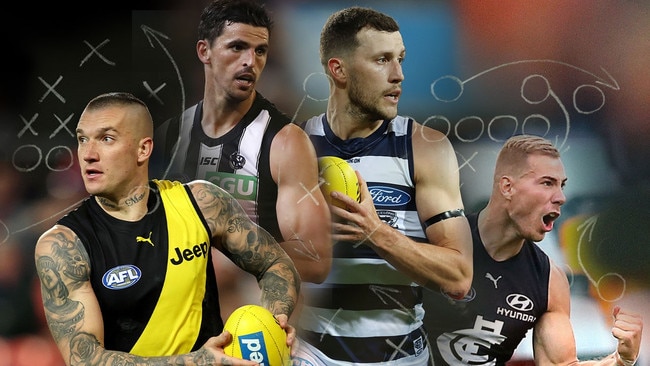
AFL News
Don't miss out on the headlines from AFL News. Followed categories will be added to My News.
Chris Judd told Carlton the secret ingredient to a successful rebuild was chemistry.
He said the Blues would benefit from the same cluster of players lining up together week after week.
Last off-season they looked at Brisbane’s template as proof it was the right path, and defenders Jacob Weitering, Lachie Plowman, Liam Jones and Kade Simpson have now played 52 games together.
Geelong coach Chris Scott will now prioritise continuity and connection over freshness, wanting his best 22 to run towards the finals together.
It is impossible to measure cohesion.
But Champion Data can put a number on just about anything else, and the main premiership ingredient is points differential from turnovers.
About 60 per cent of scores come from turnovers and twelve of the past 13 premiers have ranked in the top three.
This year Geelong, Richmond, Brisbane sit on the podium with Port Adelaide fourth and Collingwood fifth.
Who are the best pressure players? It’s a tie between Hugh Greenwood (Gold Coast) and Clayton Oliver (Melbourne) with Brandan Parfitt (Geelong) third.
Kayo is your ticket to the 2020 Toyota AFL Premiership Season. Watch every match of every round Live & On-Demand. New to Kayo? Get your 14-day free trial & start streaming instantly >
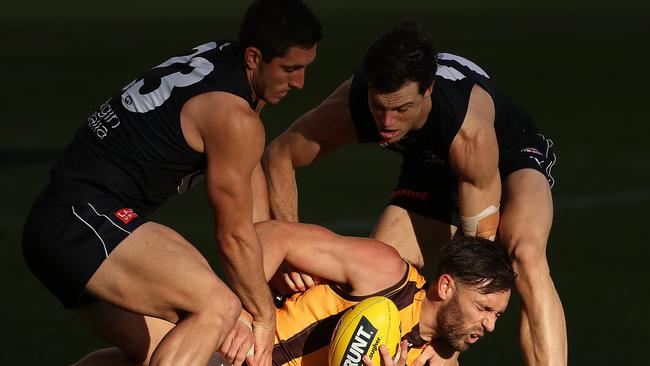
What about forward-half pressure players? Dan Butler (St Kilda), Kozzie Pickett (Melbourne) and Will Snelling (Essendon).
Who leads metres gained? Jayden Short (Richmond) has taken the ball 6457m this year, the equivalent of Punt Rd to Arden St.
Goal assists? Tom Hawkins (18), Patrick Dangerfield (17) and Zak Butters (12), with the selfless Hawkins also leading the Coleman Medal.
*** SCROLL FOR AN ANALYSIS OF EVERY CLUB’S GAME PLAN ***
St Kilda ranks No. 1 for accuracy with Tim Membrey and Butler combining for 40.15.
Plenty of those goals have been gimmes because, while the Saints rank 10th for inside 50s, they target dangerous spots.
Hawthorn calls the top of the goalsquare “POMO” (Point of Most Opportunity).
Other clubs have painted “The Cage” – a 15m box just wider than the goals – on their training ovals.
But Brisbane Lions often blaze away and rank last for accuracy.
Is it because too many Lions midfielders who don’t spend enough time on their forward craft are taking shots? Or should Chris Fagan look to POMO or The Cage?
Clubs are constantly inventing their own buzz words to keep players stimulated.
Language such as “Wizard”, “Jack” and “Bullet” all trigger a tactical switch, such as dragging a forward up to the stoppage. The terms differ at every club.
Who is the best match-day coach? Probably Scott.
Nick Riewoldt dubbed him “Chris Belichick”, after New England’s six-time Super Bowl champion coach Bill Belichick, for Geelong’s ability to disarm opponents.
The Cats often reach for the same trick bag, but the moves are so well executed they work.
How often does Mark Blicavs rotate from the wing to ruck, Rhys Stanley spit forward or Blicavs roll back and Harry Taylor or Lachie Henderson bolts forward?
They used to pull that one in 2013, when James Podsiadly would sneak behind the ball.
It is far easier to predict than conquer, and because the moves are so simple they don’t unsettle other players.
On Friday night the Cats trailed by six goals and didn’t panic.
They were smart and methodical and used the final three quarters to chip away at that margin.
Who is the AFL’s most innovative and courageous coach? Luke Beveridge, hands down.
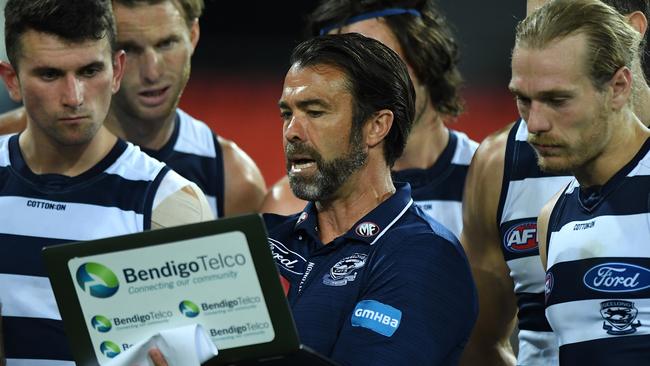
In Beveridge’s seventh game in charge of the Bulldogs he had Lin Jong and Marcus Bontempelli rucking against Aaron Sandilands.
Now Josh Dunkley is contesting hit-outs, because the Bulldogs are resigned to losing them anyway and want an extra onballer at ground level.
It’s Beveridge’s way of converting a weakness to a strength while they wait for Tim English to mature.
Beveridge’s positional changes also flow freely.
Full-forward Aaron Naughton was drafted as a key defender and halfback Hayden Crozier spent six years in Fremantle’s forward line.
Defender Zaine Cordy became a premiership forward in 2016 after a spontaneous switch at halftime in Round 19 worked.
Who would AFL boss Gillon McLachlan’s favourite coach be?
Maybe David Teague.
The Carlton coach sat in Phil Walsh’s box the night Brownlow medallists Nat Fyfe (40 disposals, one goal) and Patrick Dangerfield (38 and one) went head-to-head.
There were no tags or negative tactics and Teague has decided he wants to entertain Blues fans, referencing that enthralling match-up.
Which club is the best in thrillers? GWS.
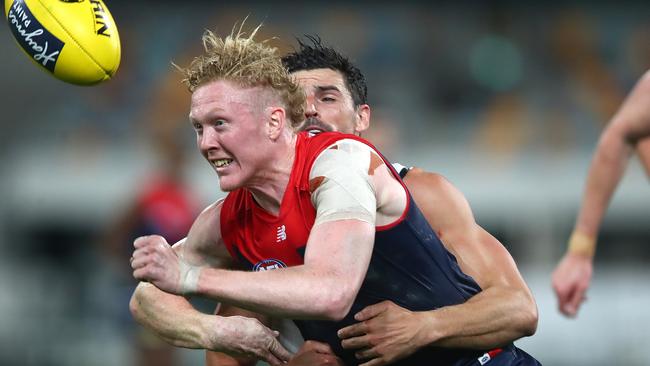
In Round 10 rival coaches tipped their hats to Josh Kelly for helping create four stoppages in the dying minutes against Essendon.
That allowed the Giants to reset defensively and drain the clock NBA-style as Kelly’s voice became as effective as a long clearance.
Since 2017 the Giants have lost just once from 15 games decided by less than a goal, going 11-1 with three draws.
This year the Saints are 1-4 in tight games, although had repeat entries in the last quarter against the Lions and were good enough to kick away late at Adelaide Oval twice.
After Round 5 Port Adelaide coach Ken Hinkley highlighted the importance of breaking even at centre clearances.
Port lost the count 13-5 and were outscored out of the middle 21-2 in a 37-point loss to the Lions.
Clubs that get smashed at the centre bounce give up field position and have to start everything out of their back half.
While Nic Naitanui’s West Coast average 11.4 points per game from a centre bounce clearance (ranked No. 1), the Cats concede 12.3 points (ranked 18th).
If they clash in a final watch out, because that’s effectively a four-goal swing and Tim Kelly’s defection is surely inflating those figures.
READ MORE:
AFL run home 2020: Where will your team finish on the ladder?
Nathan Buckley reaches 200-game milestone as coach as his journey for that elusive flag continues
Inside story: Why the Saints didn’t draft Christian Petracca with the No.1 pick in 2014
SAM LANDSBERGER and former Essendon assistant coach ROB HARDING analyse every club (All statistics sourced from CHAMPION DATA at the completion of Round 14)
ADELAIDE
+ Rory Laird has been reprogrammed since Round 8, spending 87 per cent of game time in the midfield and averaging 119 SuperCoach points, 24.6 disposals, 10.8 contested possessions, 4.4 clearances and six tackles
+ The Crows have recorded the most debutants of any side this season (9). Ned McHenry, Kieran Strachan, Lachlan Sholl, Harry Schoenberg, Andrew McPherson, Fischer McAsey, Will Hamill, Shane McAdam and Jordon Butts
– Lost clearances by a total of 127, the worst differential ever recorded after the first 14 matches of a season
– Lost contested ball by 14.7 per game, currently the sixth-worst differential recorded by any side in a season since 1999
It is difficult to identify Matthew Nicks’ game plan because the Crows rank so poorly in every area. They’ve been outscored from stoppages by 19 points per game (ranked 18th) and their midfield is the worst the AFL has seen in some time. Harding said they have four games left to bed down a template. “We’ve started to see run and carry off halfback, and if that’s their preferred method they have to build on that through the next pre-season,” he said. “Their list management decisions will also have to reflect that, so that’s not allowing Brodie Smith, Rory Laird or (free agent) Brad Crouch to leave. Nicks was keen on halfback run at GWS and their best patches of footy have been when they’re able to generate that overlap run from halfback.”
BRISBANE LIONS
+ Rank No. 1 for time in forward-half differential, points from forward-half intercept possessions and scores per inside 50
+ Fourth-best at defending a turnover and have outscored their opposition by 10.6 points from this source, ranked third
– Conceded 24.2 points per game to opposition defensive-half chains, ranked 13th and have conceded a score from 42 per cent of opposition inside 50s, ranked 11th
– Recorded the hardest shots at goal this year, resulting in the Lions recording the lowest shot at goal accuracy
Chris Fagan has given the ball movement a makeover. Last year the Lions exited defence along the boundary and went long with 41 per cent of kicks in the back half. This year they’ve used the corridor more than any other side and kicked short 61 per cent of the time. Harding said it’s a “big change” that has added another layer to their game. “They’re still very good when they kick down the line getting numbers there and working the ball through,” he said. “Their big issue is they generate long shots and wide shots, and that’s part of the reason they have a low goalkicking accuracy. Brisbane just need to tweak that final kick inside 50m and, if there’s no options, kick it long and central, like Hawthorn used to, to the top of the square, and they’ll generate better crumbing shots or marks inside 50m from easier positions to score.”
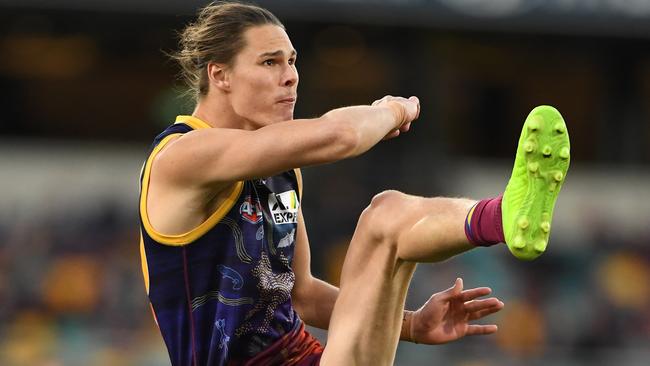
CARLTON
+ Won fourth-most intercept possessions in their forward half, rank fifth for time in forward-half differential and sixth for points from forward-half chains
+ Won clearance count by 2.3 per game, ranked sixth and their best differential since 2013
– Conceded 39.7 points per game from a turnover – ranked 15th
– Conceded 26.2 points per game from its opposition’s defensive-half chains, ranked 17th
Legend Chris Judd urged the Blues to emulate Brisbane’s blueprint and develop chemistry by letting a settled team grow together. This year that connection is paying off and David Teague backs his players to bite of aggressive kicks with targets Harry McKay, Mitch McGovern and Levi Casboult helping the Blues win field position. Harding said the No. 1 problem was learning to half momentum, and that has been addressed. The Blues have conceded eight runs of four or more goals this year, however six of those came in the first five games.
COLLINGWOOD
+ Ranked No. 1 defensively at defending an opposition defensive 50 chain which result in an inside 50
+ High volume team, ranked No. 1 for disposals and are happy to go by hand with the second-lowest kick-to-handball ratio
– Since Round 4 the Magpies have averaged just 55.9 points (ranked 13th) after averaging 68 in the first three games
– Since Round 4 they’ve converted just 38 per cent of inside 50s into a score (14th) and have been outscored a stoppage
Captain Scott Pendlebury has spent the past 18 months as a shadow tagger, selflessly playing on the opposition’s best midfielder such as Patrick Cripps on Sunday. Often in low-scoring struggles because their defensive shape behind the ball has held firm while their attacking game has disintegrated with Jordan De Goey injured and Jaidyn Stephenson ignored. Harding said overusing the ball by hand contributes to their inefficiency going forward. How often do the Magpies kick backwards multiple times and then get trapped? “That has made it harder for their forwards to get in good positions to convert,” Harding said. “Is it (Brody) Mihocek and (Mason) Cox or Mihocek and (Darcy) Cameron? Where does Jaidyn Stephenson fit? They need to settle the mix down and just get it in quick – don’t be too cute, don’t be too perfect trying to get the ball in.” Most opponents look to shutdown Collingwood’s handball receives.
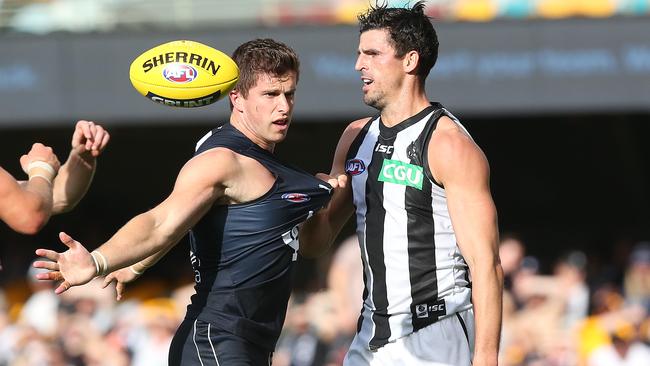
ESSENDON
+ Averaged 24.4 points per game from defensive-half chains, ranked fourth
+ Rank 2nd for metres gained by handball, behind Richmond
– Rank 16th for post-clearance pressure factor of 166
– Rank 17th for points from forward-half intercept possessions, 16th for points from forward-half chains and 15th for scores per inside 50 across 2020
– Contested footy is an issue, ranked 15th for contested possession differential and 18th for post-clearance contested possession diff
The Bombers hold their defenders deep, which means their path to goal literally starts from a lot further back than a Port Adelaide or Brisbane. It’s against the premiership model but it is the system they’re sticking with, although concerning Ben Rutten would be how many times they turn the ball over in attack and watch it travel the length of the field for a goal. “Offensively they’ve implemented the Richmond forward handball game,” Harding said. “Teams have started to plan for that and pressure those forward handballs a little bit more. They play a back-half counter-attack game and their entire game plan is very much a work in progress. They need to work out what personnel suits this game style and what doesn’t.”
FREMANTLE
+ Rank 4th for opposition scores per inside 50 and concede the sixth-fewest amount of points from turnovers
+ Overall, they have conceded 55.8 points per game to their opposition – ranked equal-fourth defensively
– Rank 18th for scores per inside 50, 17th for points scored and 16th for inside 50 differential
– Struggle to transition the ball, ranked 18th for points scored from the defensive half and 18th at generating an inside 50 from a defensive 50 chain
Ross Lyon leaves and Fremantle’s stingy defensive game actually tightens even further. New coach Justin Longmuir was Collingwood’s backline coach in 2018-19 and the Dockers’ defence is already connecting like Lego, despite injuries to Joel Hamling, Alex Pearce and Griffin Logue. In their three biggest wins they’ve leaked just 28.3 points. “The Pies’ defensive coach becomes the Freo coach and you see this well-structured, well-organised team defence behind the ball,” Harding said. “It’s kept them in games this year. Their big area to work on is their connection offensively and being able to move the ball between the arcs. “They’ve got games into young players in the positions they’re going to be successful – so that’s (Caleb) Serong as a midfielder, (Adam) Cerra and (Andrew) Brayshaw.” Could Brayshaw win the best-and-fairest? Longmuir has told his recruiters to find more outside speed and a young ruckman, and it appears an overdue cultural clean-out has already begun.
GEELONG
+ Play a controlled style, ranked No. 1 for disposal differential, uncontested possession diff, marks and have recorded the fourth-lowest play-on rate from a mark
+ Midfield is ranked No. 1 for contested possession differential, post-clearance contested possession differential and ground ball differential
– Have lost three of four matches when losing the clearance count this season
– Conceded 12.3 points from an opposition centre bounce clearance, ranked 18th
The Cats are as even as a mother’s love for her children and the growth from elite runners Sam Menegola, Cam Guthrie and Gary Rohan has eased the reliance on warriors Patrick Dangerfield and Joel Selwood. Esava Ratugolea looks unlikely to return while they have multiple scoring modes, ranked No. 3 for points from forward-half chains and No. 2 for points from defensive-half chains. Oversized defence but when Lachie Henderson (196cm), Jake Koldashnij (193cm), Harry Taylor (193cm) and Tom Stewart (190cm) control games with uncontested marks the Cats can physically exhaust teams by forcing them to waste energy chasing. The No. 1 weakness is conceding scores from centre bounce, highlighting last year’s pursuit of Todd Goldstein, while fitness suddenly appears a strength given the Cats’ 91 second-half goals (No. 1) dwarfs the 48 they’ve conceded. “There’s no flaws in the Geelong game,” Harding said. “They’ve been such a great home-and-away team the last few years it’s about being able to do it over 27 weeks (finals), not just 23. “The shorter season and shorter games helps them.”

GWS
+ Last year 46 per cent of their total score came from stoppages (highest percentage ever recorded) and this year 44 per cent has come from this source
+ Have averaged 27.5 points per game from stoppages this season – ranked third
– Forward-half game is struggling ranked 14th for time in forward-half differential, inside 50 differential and 16th for turnovers created in their forward half
– Struggle to defend transition, ranked 16th at allowing the opposition to generate an inside 50 from a defensive 50 chain
Leon Cameron admitted the Giants needed a better system and that is because they are a strong stoppage team and sloppy everywhere else, unable to lock the ball in their front half. While GWS has been ultra-efficient in wins – kicking 13 goals from 26 entries against Hawthorn, for example – it does not appear a sustainable brand. Harding said the attack needed to add pressure to efficiency. “Can three of Can Jeremy Cameron, Harry Himmelberg, Jeremy Finlayson and Jake Riccardi play in the same forward line as Toby Greene when none of them are great pressure players?” he said. “Or do one of the talls come out and a more defensive-minded small forward who puts on that run-down pressure, like a Kozzie Pickett (Melbourne), comes in to better balance it?” Riccardi’s emergence could see the out-of-contract Finlayson traded, particularly if GWS wants to save dollars to re-sign Cameron.
GOLD COAST
+ Average age of 24 is the youngest in the AFL this season
+ Conceded a score from just 37 per cent of opposition entries, ranked 3rd and concede the fourth-fewest amount of points from an opposition clearance
+ Have applied a pressure factor of 188 this season – ranked fifth.
– Rank 16th for both disposal differential and uncontested possession differential and ball use is an issue, ranked 18th for kicking efficiency
– Need to improve turnover game, conceded the sixth-most points from a turnover and rank 12th for points scored from turnovers
In 2018 Stuart Dew instructed his team to play one-on-one and focus on fundamentals and now a system is being installed. Gold Coast loves Ben King’s sharp acceleration and fluent set-shot and Matt Rowell will arguably be the ‘recruit’ of 2021. Tough midfielder Hugh Greenwood has become the Suns’ ozone layer and is the AFL’s No. 1 pressure player. “When you play games at Metricon Stadium, particularly at night they’re often in slippery conditions, so they need to be a strong contest and pressure team,” Harding said. Yep, that suits Greenwood.
HAWTHORN
– Average age of 27.2 is the second-oldest across the competition this season behind Geelong
– Worst pressure team in the AFL, applying a pressure factor of 179 – AFL average is 185
– Midfield is getting smashed, ranked 17th for contested possession differential, ground ball diff and clearance differential
+ Rank 7th for forward-half turnovers created, however are not cashing in – ranked 12th at points generated from this source
Alastair Clarkson conceded his midfield got “smacked” around the ball in Round 2 and sadly that’s become a theme. Despite Tom Mitchell’s return the Hawks have lost the contested ball count by 14.5 (ranked 17th) and have been outscored by 5.7 points from stoppages (16th). Clarkson spent the past decade counting on mega scores from turnovers as Luke Breust, Paul Puopolo and Cyril Rioli have run riot, but this year they are ranked 16th. “They started the year trying to play – as they did late in 2019 – a bit quicker with the ball, playing on aggressively,” Harding said. “But they’ve gone back to more of the traditional Hawthorn; kick, mark, shift the ball in offence. That’s their DNA over a period of time.” The Hawks’ age is inflated by Shaun Burgoyne, 37, but there is a hole in the list from 23-25, which won’t be helped by the loss of James Sicily (knee) for most of 2021. Players that age can only be traded in, too, as they have not yet qualified for free agency.
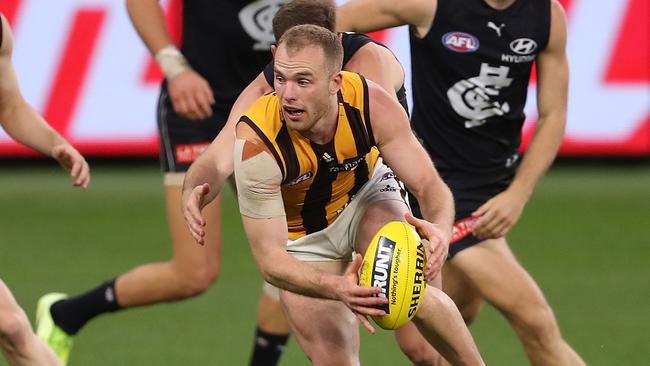
MELBOURNE
+ Have won the contested possession count by eight per game – ranked 3rd
+ Under new fitness boss Darren Burgess the Demons have had the third-fewest amount of injuries to their best 22
+ Conceded the fewest amount of points from a clearances and rank 3rd for points from clearance differential (+5.9)
– Conceded 24.6 points per game to their oppositions defensive half chains – ranked 14th
Sam Weideman’s belated selection in Round 6 has transformed Melbourne’s season, helping fix the forward connection that had plagued the Demons in the previous 27 games. The Demons have gone from the worst exponent of the ‘money kick’ (Rounds 1-5) to the fifth-best (Rounds 6-14) as Clayton Oliver, Jack Viney and Angus Brayshaw lowered their eyes. They’ve invested heavily in the back half with All-Australian chance Steven May and Jake Lever taking home 10 per cent of the salary cap, but their aerial dominance and intercept game gives the Dees a springboard. But Harding cautioned them against going to tall at the other end. “Weideman and Luke Jackson or Tom McDonald are the key forwards, and then they have Mitch Hannan, Bailey Fritsch and Jake Melksham as mid-sized marking types. “When they play all five they don’t put any pressure on, and that happened in the Bulldogs game. Too much got left to (Charlie) Spargo and (Kozzie) Pickett and the ball got out far too easily and ripped through.”
NORTH MELBOURNE
+ From Rounds 1-12, North Melbourne ranked 2nd for clearance differential and fifth for contested possession differential
+ Go quick and direct, using the corridor the third-most when exiting defence and boast the sixth-highest mark play-on rate in the back half
– Rank 17th for time in forward-half differential and 16th for points generated from forward-half intercepts
– Lost the most amount of games to their best 22 this season
Coach Rhyce Shaw had just 28 players to choose from on Sunday – and Jared Polec still can’t get a game – with hardnuts Ben Cunnington and Jack Ziebell missing a combined 20 matches. The Roos largely play on effort and energy, ranking No. 2 for pressure and No. 1 for rundown tackles, but need to balance chaos with control because they are ranked last for allowing opposition to score once inside 50. How easy was it for Gold Coast to finish its work on Sunday night? The Roos’ contested ball numbers are also inflated because they rank No. 1 for free kicks. Overall they languish 12th for ground balls and 16th for tackle differentials. That’s alarming, because this club’s DNA is to be elite in clearance, contests and tackles, which points to Polec’s omission. The Roos hold two first-round picks and could get a third for Ben Brown, but can such a small club financially afford to completely bottom out?
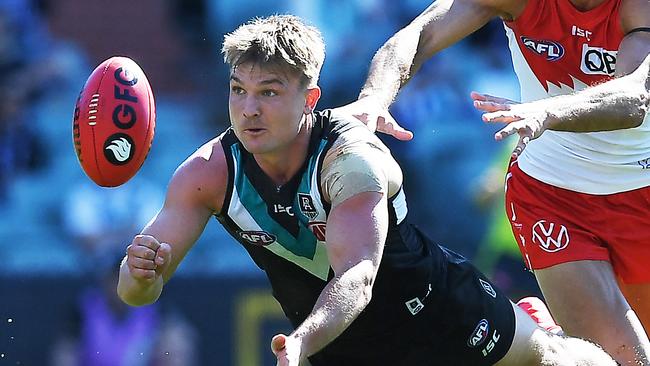
PORT ADELAIDE
+ Stoppage domination from last year has rolled on, ranked fourth for contested possession differential (+7.5) and No. 1 for clearance differential (+4.9)
+ Rank No. 2 for time in forward-half differential, No. 1 for forward-half intercept possessions and fourth for points from turnover differential
– Haven’t won a game when losing contested footy, losing the count against Brisbane (-13), St Kilda (-11) and Geelong (-23)
– They have recorded a shot at goal accuracy of 44% this season – ranked 17th
Contested ball is their No. 1 marker, led by bulls Travis Boak and Ollie Wines. When they win it at the contest they move the ball quickly and can lock it in their front half. But when they are beaten on the spread those bigger bodies can look a little one-paced. Are they too predictable going forward? Ken Hinkley says they’re not frightened to take Charlie Dixon away from the goalsquare, but 33 per cent of inside 50s have targeted the spearhead (ranked No. 2 in the AFL, behind Ben King). Alarmingly, their stoppage work is dipping and they have conceded the fifth-most points from this source since Round 8.
RICHMOND
+ Have averaged 28 points from defensive-half chains his season, ranked No. 1
+ Still strong front half and turnover numbers, ranked third for both time in forward-half differential, forward-half intercept possessions and 2nd for points from turnover differential
– Outscored from stoppages in every game they haven’t won this year. Ranked 15th for clearance differential and 14th for points from clearances.
– Rounds 1-13, conceded a score from 43 per cent of opposition inside 50 entries – ranked 15th.
The Tigers invite chaos and their pressure rating reached a season-high against West Coast on Thursday. It must be spring because Dustin Martin has recharged his mojo and Richmond’s brand is humming. Coach Damien Hardwick likes to outnumber at stoppages and pulls a forward, such as Kane Lambert, into the midfield as Martin spits forward. They are the second-best in the AFL at taking the ball from defence to attack and they boast the second-best inside 50 differential, often winning repeat entries. Shai Bolton has evolved into a game-changing midfielder while they rank third for time in forward half and are building in a similar manner to 2017 and 2019. Has anyone seen Noah Balta and Alex Rance in the same room this year? Premiership players Marlion Pickett, Jack Graham, Toby Nankervis, Nathan Broad and veteran Bachar Houli are all unsigned though and as the Tigers hunt a third flag in four years rivals will try to pick holes in their list.
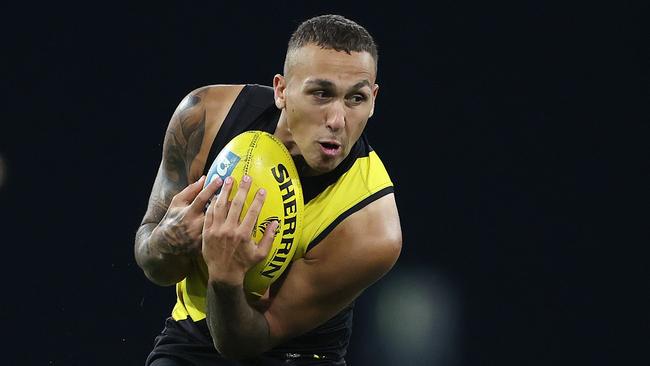
ST KILDA
+ Boast the highest shot at goal accuracy in the AFL courtesy of generating the easiest shots at goal
+ Rank 2nd for scoring from forward-half chains, fourth for points scored and points from clearances
+ Play quick and keep the ball moving – second-lowest metres gained per kick, average the fourth-most marks and have recorded the second-highest mark play-on rate
– Have lost all five matches when their opposition has taken more marks
Under Alan Richardson they had such an emphasis on applying pressure they were like bees to a honey pot, with up to eight players approaching the ball carrier who could handball it over the top or find an easy mark to leave the Saints eating dust. Rivals believed it lacked method although this year they are pressuring smarter and not overcomitting numbers. Harding said a key marker was St Kilda’s ability to prevent the opposition taking marks so they could control the speed of the game. The Saints spent the COVID-19 shutdown break going to school on how to create easy looks to fix their accuracy and they lead the AFL for open goals with Dan Butler the No. 2 pressure forward. The burst out of the backline resembles the Bulldogs with speedsters Zak Jones, Nick Hind, Bradley Hill and Butler encouraged to play with a sense of adventure while Jack Steele playing like a $750,000 midfielder.
SYDNEY
+ Average age of 24.4 is the second-youngest in the AFL and they’ve used the third-most players (38)
+ Only allowed the opposition to score a goal from 19 per cent of inside 50s, ranked 3rd defensively
– Struggle to lock the ball in their front half, ranked 15th for time in forward-half differential, 17th for inside 50 differential and points from forward-half chains
– Midfield struggling, ranked 16th for contested ball differential, clearance differential and 17th for points from stoppage differential
Andrew Demetriou branded the Swans “ugly ducklings” 15 years ago and they are still hard to score against. But that’s down to a sound defensive base rather than negative tactics, despite Damien Hardwick’s claim Sydney had 75,000 people in Richmond’s forward line. Harding says they play “back-shoulder defence” and, led by Dane Rampe, they’ve won 35 per cent of defensive one-on-ones this year. Coach John Longmire has exposed his list with James Rowbottom demanding a midfield place and Tom McCartin and Nick Blakey accelerating in Buddy’s absence. A second-straight year out of finals for the first time since 1995 and facing another fight to keep Tom Papley, who is destined to win his first best-and-fairest.
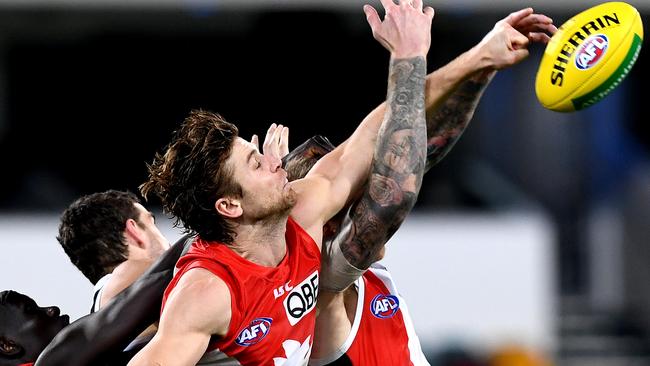
WEST COAST
+ Since the 1-3 start to the season the midfield rank fifth for both contested possession differential and post-clearance contested possession differential
+ Play a safe and controlled brand with the third-highest kick-to-handball ratio and average the second-most marks and use the boundary exiting defence
+ Averaged the fourth-most points from turnovers and have converted 43 per cent of inside 50s into a score, ranked fifth
+ Generated the fifth-most points from their defensive-half chains
The Eagles have slipped to 0-3 in slippery conditions playing at night in Queensland and the key question is whether that tropical dew will wash away their flag hopes. Can Adam Simpson’s men execute their expansive kick-mark game style under the Gabba or Metricon Stadium lights? “They do control the ball a lot with that kick-mark game and they have the benefit of being the No. 2 clearance team – which gives you field position – with the best tap ruck (Nic Naitanui),” Hading said. “So their centre bounce clearances can be a real weapon.” They outscore opponents by two goals per game from centre bounce (No. 1) and boast a sharp goalkicking accuracy despite taking plenty of low-percentage chances. It is usually a slow but calculated build-up where Josh Kennedy, Jack Darling and Liam Ryan finish the work like Santa on Christmas Eve. Richmond focused on limited West Coast’s time in possession and uncontested marks on Thursday with Hardwick thrilled that Tom Barrass and Jeremy McGovern combined for just five marks, even if that was two more than Tom Lynch and Jack Riewoldt. The Tigers won contested marks 10-2. Tim Kelly, Andrew Gaff, Brad Sheppard and Naitanui are all chasing their first premiership despite the club’s 2018 triumph.
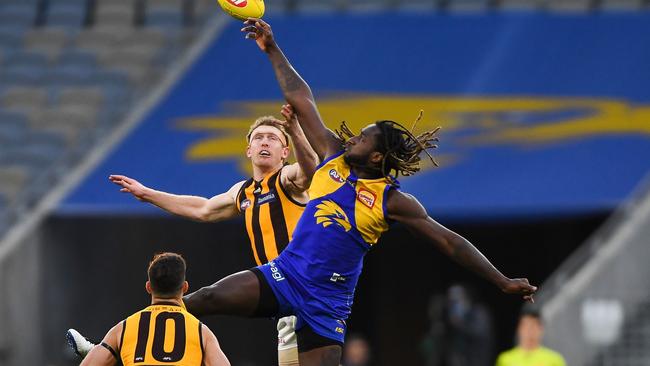
WESTERN BULLDOGS
+ Lightning-quick game style – play-on more than any other team, take the second-fewest marks and have the lowest kick-to-handball ratio
+ No. 1 for moving the ball from the back 50 to the forward 50 and No. 2 for points generated from defensive 50
– Last for hit-outs (-22.5 per game) and hit-outs to advantage (-5.5)
– Ranked 16th for opposition scores per inside 50 and 15th for points conceded from a stoppage
Harding said “rucks are like wicketkeepers – you only need one” and yet coach Luke Beveridge is playing Tim English at third man, with Josh Dunkley (190cm) recently attending the most ruck contests. But the Bulldogs were keen for Tom Liberatore to return this year without sacrificing a midfielder and Dunkley’s agility gives the Dogs another ground-level combatant to help shark the clearance. It’s edgy and unorthodox, but so is Beveridge as they wait English to mature. For the second-straight year the Dogs are ranked No. 1 at moving the ball the length of the field with All-Australian-bound Caleb Daniel’s precise kicking as the halfback link man critical. Handball club – where the Dogs practice nailing targets with underground and overhead handballs at rapid pace – is still helping the midfielders convert congestion into open spaces Dan Andrews would approve of. Josh Bruce has disappointed and the Dogs desperately need a pressure forward – they would’ve loved to draft Kozzie Pickett last year – because they are vulnerable on the turnover. “They’re the third-worst at conceding inside 50s from turnovers in their forward 50m,” Harding said.
